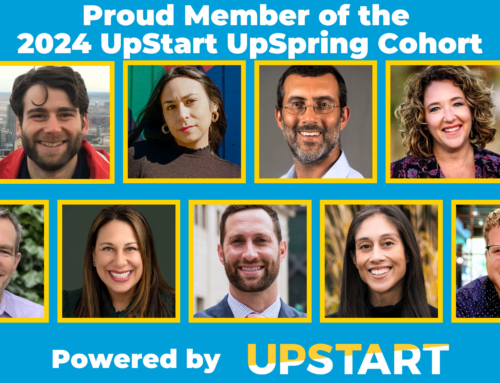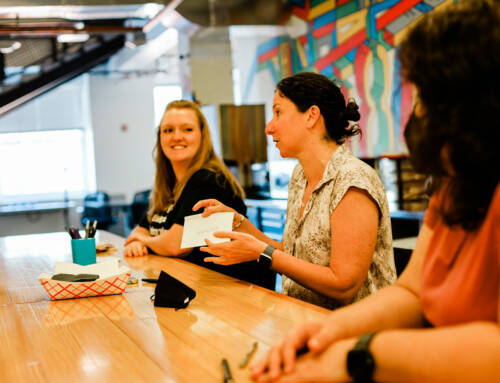By Aliza Mazor, UpStart’s Chief Field-Building Officer | Journal Of Jewish Education
To survive we must adapt and change. We must disrupt, iterate, and take risks. This is the bold challenge posed by Dr. Jonathan Mirvis in his new book, It’s Our Challenge: A Social Entrepreneurship Approach to Jewish Education. As someone who has worked side by side with Jewish social entrepreneurs for the past two decades, I could not agree more. We stagnate at our peril. However, it is not enough to merely be bold and creative. For innovation, entrepreneurship, and intrapreneurship to make strong contributions to the Jewish future we need to really understand how these processes work.
We need to understand how concepts born in the commercial sector are best adapted for use in the nonprofit sector. We need to delve into cases of successful entrepreneurs and unpack the factors that contributed to their success. We need to trace the process that gives birth to new norms and practices, pushing beyond the novelty of a singular innovation. These are the offerings contained in It’s Our Challenge: A Social Entrepreneurship Approach to Jewish Education. Dr. Mirvis, himself an educator, entrepreneur, and senior lecturer at the Melton Centre for Jewish Education at The Hebrew University of Jerusalem, weaves together an academic analysis of social entrepreneurship with case examples and vignettes about Jewish educational entrepreneurs. The format is engaging and the content is rich. Dr. Mirvis inter-weaves theory and practice, making the case for entrepreneurship, but also demonstrating how it is integrated into a broader landscape. In this book, innovation is not the silver bullet, but a tool that needs to be honed and refined and one that belongs in every Jewish communal toolkit.
Dr. Mirvis knows and understands entrepreneurs. His own experience leading the Florence Melton Mini-Schools attests to that. He knows that entrepreneurs at their core are problem solvers. They are so bothered by the status quo that they cannot sit still—how could this become relevant to more people? How could we make this more convenient and accessible? How could this be more affordable? They don’t rest at night until they have cracked the code. As Dr. Mirvis states: “entrepreneurs are not always the first, but they are the most persistent and successful.” Entrepreneurship is not only about having the most creative ideas, it is about figuring out how to move them forward.
This book makes many important contributions to an emerging field. Dr. Mirvis offers us a taxonomy for innovation and entrepreneurship in Jewish education that is clear and straightforward. This is particularly helpful because there has been a tendency to overuse and conflate terms. Dr. Mirvis carefully distinguishes between innovation and social entrepreneurship, between adding social value and engaging in social enterprise. One of the most important distinctions he draws is around the ways in which social entrepreneurship is different from commercial entrepreneurship. Business concepts are applicable to educational entrepreneurship, but they also need to be adapted. Adjustments must be made for critical differences in context. Dr. Mirvis draws several very helpful distinctions.
First he distinguishes between “sustaining innovation” and “disruptive innovation.” All Jewish educators should be engaged in sustaining innovation—questioning assumptions, tweaking endeavors, and promoting a culture of constant improvement. When the model itself is broken, we must engage in “disruptive innovation.” All educators should be innovators. Disruption should be saved for our most puzzling and intractable challenges. Dr. Mirvis also distinguishes between “social need entrepreneurship” and “social vision entrepreneurship.” Social need entrepreneurship responds to immediate and pressing needs. Social vision entrepreneurship looks beyond what exists to what might be. Both are needed in Jewish education.
Dr. Mirvis also advocates distinguishing between different customer types. Jewish institutions tend to lump customers together or to segment them by age, demographics, etc. Dr. Mirvis asserts that even within a tightly defined target audience (for example, parents of pre-school-aged children contemplating Jewish nursery school) you will have four customer groups: “consumers” are committed ideologically, “customers” see it as a preference but may have other competing preferences, “overshot customers” may be open to this option under ideal circumstances, “noncustomers” might be open to it if they were aware of it, and “never-will-be-customers” will not engage no matter what. According to Dr. Mirvis, each of these customers has different motivations and price points and each requires a differentiated outreach and engagement strategy. A big light bulb went off for me when reading this chapter, as I have watched Jewish educational organizations struggle to engage “the unaffiliated.”
Often they are doing this because funders have pressed them to reach large numbers of Jews who have little or no connection to Jewish life. They are continually disappointed when they track outcomes because their “unaffiliated participants” are not unaffiliated enough. My immediate thought was that there needs to be a differentiated approach to reaching unaffiliated Jews in the overshot and noncustomer categories and acknowledgment that some unaffiliated Jews may remain in the never-will-be customer category. Dr. Mirvis also asserts that the entrepreneur needs to understand the “job to be done” from the participant’s perspective. Participants may define what they are seeking in a way that is completely different from what educators are offering.
Another keen insight that Dr. Mirvis offers relates to “red ocean” versus “blue ocean” market places. Red ocean markets are overcrowded and highly competitive, whereas blue oceans have more opportunity. Some of the most successful entrepreneurs in Jewish education over the past decade have set off for blue oceans, creating novel and appealing products while marketing to customers who are not consuming other Jewish educational offerings. In the final chapter, he provides examples of the mechanisms that can be used to bring innovation into a broader market and multiply impact. I found the concepts of “bridges, platforms, and changing the rules” helpful and eye opening.
Dr. Mirvis places innovation in a long-term context. He states that the “entrepreneurs of yesterday are the institutional landscape of today.” This is a helpful framing that positions innovation as ongoing versus episodic. We must shepherd the best innovations of today to the greatest level of stability so that they will become the “innovating establishment” of tomorrow. In this frame, innovation and establishment are not viewed as opposites but rather part of a healthy continuum. Some of the most successful innovations featured in the book such as Moishe House, PJ Library, and Melton Mini-School have models that are predicated on partnership with long-standing institutional frameworks. In these examples, innovation and institution are not two poles but are actually a synergistic force for change.
While I enjoyed the book and know that I will return to it and reference it extensively, there were also chapters that left me with lingering questions. I would have liked to read more examples of failures and more analysis of the trajectory of disruptive innovations over time. Which ones went out of business and why? Did any competitors come along and do it better? What enabled some initiatives to stand the test of time and continue to innovate while others shuttered their doors? I would have liked to hear more from entrepreneurs about the struggles and challenges they faced and how they overcame them.
It would have also been interesting to hear more from the viewpoint of funders and investors. In the Jewish world funders play a critical role in the innovation ecosystem providing everything from seed funding to capacity-building to sometimes serving as the entrepreneurs themselves. Funders in It’s Our Challenge appear primarily as angel investors and cheerleaders. It would have been great to see their dynamic role fleshed out more thoroughly.
Dr. Mirvis categorizes initiatives as “high impact” based on evidence from external evaluation and trusted informants. Data and metrics are critical for helping us understand our progress toward impact, but they often mire us in bean counting without enabling us to see the bigger picture. Did norms change? Did policy change? Did this become the dominant model? How did it impact overall trends? As a community we need to challenge ourselves to define impact and to understand the difference between creating great programs that generate high customer satisfaction (no small feat) and those initiatives that shift paradigms and move the needle on our greatest communal challenges.
This is Dr. Mirvis’s first book on social entrepreneurship in Jewish education and I hope it will not be his last. As a capacity-builder who works closely with social entrepreneurs to help them improve their outcomes, I am eager for more research and reflection on this field that integrates theory and practice. The observations offered in It’s Our Challenge: A Social Entrepreneurship Approach to Jewish Education provide rich food for thought for entrepreneurs, funders, institutional leaders, lay leaders, capacity-builders, and customer/consumers in the world of Jewish education. In a Jewish education world beset by challenges and scarcity mindsets, this book demonstrates that the glass is not only half-full; it is filled to the brim with creativity, potential, and can-do spirit.
The individuals and projects profiled in this book paint a hopeful picture of the Jewish future—one where offerings are exciting, relevant, and varied; where participants are deeply understood; where barriers to entry are lowered or removed; and where increasing numbers of Jews find their place in Jewish life. It is not a far-fetched unrealistic dream, it is our challenge and we are up to the task.
Our purpose is to enable entrepreneurs to bring bold Jewish ideas to light. We help them reach Up to people in new ways that are meaningful, more inclusive, and create a brighter future for our Jewish community and the world we share.





